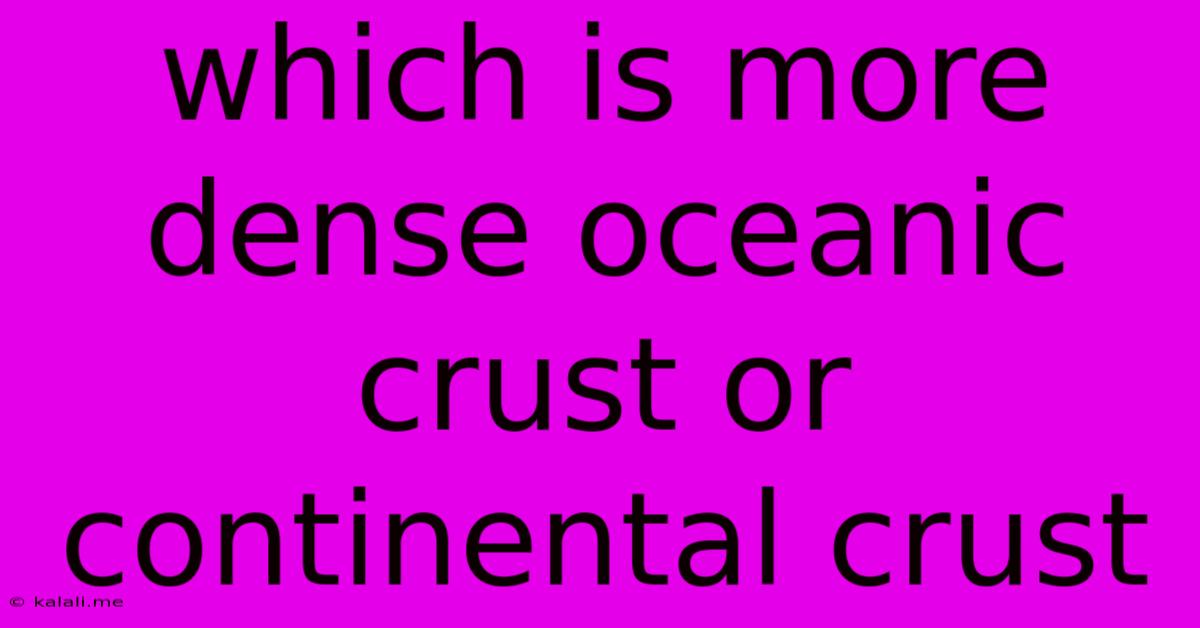Which Is More Dense Oceanic Crust Or Continental Crust
Kalali
May 10, 2025 · 3 min read

Table of Contents
Oceanic Crust vs. Continental Crust: Unveiling the Density Difference
Meta Description: Discover the key differences between oceanic and continental crust, focusing on their density. We explore the composition, formation, and implications of this density contrast for plate tectonics and Earth's geological processes.
The Earth's crust, the outermost solid shell, is divided into two primary types: oceanic crust and continental crust. While both are composed of silicate rocks, they differ significantly in their composition, thickness, and most importantly, density. Understanding this density difference is crucial to comprehending plate tectonics and various geological phenomena.
Compositional Differences: A Key Factor in Density
The fundamental reason for the density disparity lies in their contrasting compositions. Oceanic crust is predominantly composed of mafic rocks, primarily basalt and gabbro. These rocks are rich in iron and magnesium, giving them a higher density. Think of it like this: iron and magnesium are heavier elements than those predominantly found in continental crust.
Continental crust, on the other hand, is largely composed of felsic rocks, such as granite and andesite. These are richer in lighter elements like silicon and aluminum. This difference in elemental composition directly translates to a lower density for continental crust.
Density Values: A Quantitative Comparison
While precise values can vary based on specific location and composition, a general comparison reveals the crucial difference:
- Oceanic crust: typically has a density around 2.9 g/cm³ to 3.0 g/cm³.
- Continental crust: typically has a density around 2.7 g/cm³ to 2.8 g/cm³.
This seemingly small difference in density – approximately 0.2 g/cm³ – has profound geological implications.
Implications of Density Differences: Plate Tectonics and Subduction
The density contrast between oceanic and continental crust is the primary driver behind the process of subduction. Because oceanic crust is denser, when oceanic and continental plates collide, the denser oceanic plate is forced beneath the lighter continental plate. This process creates deep ocean trenches, volcanic mountain ranges, and significant seismic activity along subduction zones.
Similarly, when two oceanic plates collide, the older, denser plate will subduct beneath the younger, less dense plate. This again leads to the formation of volcanic island arcs and deep trenches. The density difference dictates which plate will sink beneath the other.
Thickness: Another Contributing Factor
While density is the primary factor, it's worth noting that the thickness of each crust type also plays a role. Oceanic crust is relatively thin, typically ranging from 5 to 10 kilometers in thickness, while continental crust is significantly thicker, ranging from 30 to 70 kilometers. Although thinner, the higher density of oceanic crust still makes it heavier overall than comparable volumes of continental crust.
In Conclusion: Density as a Defining Feature
The difference in density between oceanic and continental crust is a fundamental aspect of plate tectonics and global geology. This density contrast, driven by compositional variations, dictates the behavior of tectonic plates during collisions, ultimately shaping Earth's surface features and driving geological processes. Understanding this fundamental difference allows for a deeper comprehension of our planet's dynamic nature.
Latest Posts
Latest Posts
-
How Do You Divide Rational Numbers
May 10, 2025
-
53 Inches To Feet And Inches
May 10, 2025
-
How Many Gallons In 7 Liters
May 10, 2025
-
How Much Is 50g In Ounces
May 10, 2025
-
How Many Cups Are In 6 Gallons
May 10, 2025
Related Post
Thank you for visiting our website which covers about Which Is More Dense Oceanic Crust Or Continental Crust . We hope the information provided has been useful to you. Feel free to contact us if you have any questions or need further assistance. See you next time and don't miss to bookmark.